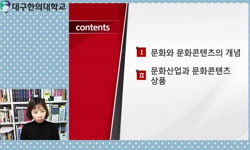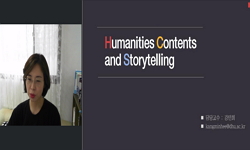The centre of the gravity of the world’s politics and economics is gradually shifting towards Asia form Europe and North America in the 21st century. Especially in China and Northeast Asian countries are pursuing cultural development based on their ...
http://chineseinput.net/에서 pinyin(병음)방식으로 중국어를 변환할 수 있습니다.
변환된 중국어를 복사하여 사용하시면 됩니다.
- 中文 을 입력하시려면 zhongwen을 입력하시고 space를누르시면됩니다.
- 北京 을 입력하시려면 beijing을 입력하시고 space를 누르시면 됩니다.
부가정보
다국어 초록 (Multilingual Abstract)
In this context, China has carried out economic retaliation against South Korea over THAAD, which also hurts China’s economy. As a result, structural weaknesses of Korean economy and industry on China trade are emerging as an urgent task. Among these changes, how will we, who experienced colonial cultural imperialism, recognize and accept various cultural conflicts beyond the political and economic problems with China? As a method to find its solutions, this study looked at the interrelated aspects of ‘China’s ban on Hallyu’ and ‘cultural contents industry’.
The centre of the gravity of the world’s politics and economics is gradually shifting towards Asia form Europe and North America in the 21st century. Especially in China and Northeast Asian countries are pursuing cultural development based on their economic power and are aiming for globalization. China is heading towards the ‘China Dream’ and ‘The Powerful Culture’, and Japan is steadily maintaining its ‘move towards right-wing policy’ based on a country’s economic growth. It is obvious that Korea’s cultural strategy and policy setting is a very important period in the realization of the hegemonic dominance of the world culture. Since the 2000s, the Chinese government’s cultural policy has emphasized the revival of traditional culture based on the expansion of Cultural Power of Imperial. In particular, in 2011, the Chinese government adopted to ‘build up the socialist cultural powerhouse’ as a new national vision. To achieve this, the Chinese government has set up the cultural industry as a national strategic industry, and has strongly promoted the national image and strengthened soft power.
In this context, China has carried out economic retaliation against South Korea over THAAD, which also hurts China’s economy. As a result, structural weaknesses of Korean economy and industry on China trade are emerging as an urgent task. Among these changes, how will we, who experienced colonial cultural imperialism, recognize and accept various cultural conflicts beyond the political and economic problems with China? As a method to find its solutions, this study looked at the interrelated aspects of ‘China’s ban on Hallyu’ and ‘cultural contents industry’.
참고문헌 (Reference)
1 김재범, "한한령의 원인과 대응정책" 한국문화산업교류재단 2017
2 주민욱, "한한령(限韩令)에 대한 중국 언론보도 사회관계망분석(SNA) 연구" 대한중국학회 (60) : 285-301, 2017
3 김상욱, "한한령(限韓令)과 한국 문화산업"
4 신건식, "한한령(限韓令), 기회가 될 수 있다"
5 "한한령"
6 김현경, "포기할 수 없는 중국 시장, 전략의 다변화 필요"
7 김윤지, "최근 중국 경제제재 파급효과 추정" 한국수출입 은행 1-9, 2017
8 한일경제협회, "최근 일본의 대외 통상정책" 한일산업기술협력 재단 일본지식정보센터 1-6, 2013
9 정훈, "최근 일본 통상정책의 변화와 우리의 대응방안" KIEP대외경제정책연구원 1-108, 2017
10 김휘정, "중국의 한한령(限韓令)과 문화콘텐츠산업의 과제" 국회입법조사처 (1264) : 1-4, 2017
1 김재범, "한한령의 원인과 대응정책" 한국문화산업교류재단 2017
2 주민욱, "한한령(限韩令)에 대한 중국 언론보도 사회관계망분석(SNA) 연구" 대한중국학회 (60) : 285-301, 2017
3 김상욱, "한한령(限韓令)과 한국 문화산업"
4 신건식, "한한령(限韓令), 기회가 될 수 있다"
5 "한한령"
6 김현경, "포기할 수 없는 중국 시장, 전략의 다변화 필요"
7 김윤지, "최근 중국 경제제재 파급효과 추정" 한국수출입 은행 1-9, 2017
8 한일경제협회, "최근 일본의 대외 통상정책" 한일산업기술협력 재단 일본지식정보센터 1-6, 2013
9 정훈, "최근 일본 통상정책의 변화와 우리의 대응방안" KIEP대외경제정책연구원 1-108, 2017
10 김휘정, "중국의 한한령(限韓令)과 문화콘텐츠산업의 과제" 국회입법조사처 (1264) : 1-4, 2017
11 장보형, "중국의 사드보복이 경제 및 산업에 미치는 영향" 하나금융경영연구소 1-35, 2017
12 정환우, "중국의 가공단계별 수출입구조로 본 중국 내수시장 변화와 시사점" 10 : 1-50, 2011
13 "중국, 한한령 ‘해빙 모드’"
14 이임자, "중국 정부의 한국 여행 제한 조치가 국내 소비재산업에 미치는 영향 분석" (19) : 1-12, 2017
15 주민욱, "중국 언론보도를 통해 살펴본 한한령(限韩令)과 우리의 대응 방안" 차이나 매거진
16 이태형, "중국 문화정책의 통시적 고찰" 한국국제문화교류학회 5 (5): 81-100, 2016
17 "이거 짝퉁인데? 中, 한류 베낀 예능 버젓이 판매도"
18 이순임, "시진핑 출범 이후 중국 방송정책의 특징과 변화" 부산울산경남언론학회 19 (19): 93-138, 2015
19 "상어가족"
20 "상어가족"
21 전해영, "사드 갈등 장기화에 따른 국내 관광산업 손실규모 추정" 현대경제연구원 1-9, 2017
22 "뽀로로 넘은 ‘상어가족송’, 中기업이 유사품 제작⋅유통"
23 정부관계부처합동, "방한 관광시장 활성화 방안"
24 "리커창 “무역전쟁 동참하라” 삼성⋅현대차 “배터리 문제 풀자”"
25 남송우, "동북아시아 지역의 문화정책의 흐름과 교류의 방향성 모색" 동북아시아문화학회 1 (1): 5-17, 2015
26 "귀요미송"
27 "韓媒曝光中國‘限韓令’9月1日電視台實施"
28 "限韓令原因是什麼? 限韓令升級為什麼讓韓國恐慌?"
29 "限韓令"
30 "關于進一步加強網絡視聽節目創作播出管理的通知"
31 "廣電總局下發特急文件 進一步規範網絡視聽節目傳播秩序"
32 "外交部部長王毅在2017年國際形勢與中國外交研討會開幕式上的演講"
33 "外交部發言人耿爽主持例行記者會"
34 "國家新聞出版廣電總局要求“新浪微博”, “ACFUN”等網站關停視聽節目服務"
35 "十二五時期文化改革發展計劃綱要"
36 우다웨이, "中정부, 한 번도 ‘금한령’ 발표 안 해…자발적 행동"
37 "中韓關系轉圜?關于“薩德”有些疑惑不得不說"
38 "中國文化産業振興規劃"
39 外交部發言人華春瑩 主持例行記者會, "中國外交部網站"
40 "中國共産黨第十七屆中央委員會第六次全體會議公報"
41 "中, 사드 보복성 규제...난기류에 빠진 ‘中 한류’"
42 "“限韓令”能否逼韓國放棄薩德"
43 "“限韓令”可能真的要解禁了 但衛視和網站的購劇潮恐難再現?"
44 권기영, "‘한한령(限韓令) ’을 통해 본 중국 대외문화정책의 딜레마" 중국문화연구학회 (37) : 29-54, 2017
45 이현우, "2017년 2분기 콘텐츠산업 동향분석 보고서" 한국콘텐츠진흥원 2017
46 문체부, "2017년 2분기 국내 콘텐츠산업규모"
47 허지영, "2017 콘텐츠산업 수출 현황 및 전망" 한국콘텐츠진흥원 (17-16) : 1-8, 2017
동일학술지(권/호) 다른 논문
-
현대 중국어 목적/결과 관계 복문에 사용되는 ‘호(好)’의 통사·의미적 특징
- 고려대학교 중국학연구소
- 임소정 ( Lim Sojeong )
- 2018
- KCI등재
-
- 고려대학교 중국학연구소
- 장선우 ( Chang Sunwoo )
- 2018
- KCI등재
-
<고풍(古風)>59수(首)에 나타난 리백(李白)의 자아(自我)
- 고려대학교 중국학연구소
- 윤석우 ( Yoon Seokwoo )
- 2018
- KCI등재
-
- 고려대학교 중국학연구소
- 이승신 ( Lee Seungshin )
- 2018
- KCI등재
분석정보
인용정보 인용지수 설명보기
학술지 이력
| 연월일 | 이력구분 | 이력상세 | 등재구분 |
|---|---|---|---|
| 2022 | 평가예정 | 재인증평가 신청대상 (재인증) | |
| 2019-01-01 | 평가 | 등재학술지 유지 (계속평가) |  |
| 2016-01-01 | 평가 | 등재학술지 선정 (계속평가) |  |
| 2015-12-01 | 평가 | 등재후보로 하락 (기타) |  |
| 2011-01-01 | 평가 | 등재학술지 선정 (등재후보2차) |  |
| 2010-06-24 | 학술지명변경 | 외국어명 : 미등록 -> JOURNAL OF CHINESE STUDIES |  |
| 2010-01-01 | 평가 | 등재후보 1차 PASS (등재후보1차) |  |
| 2008-01-01 | 평가 | 등재후보학술지 선정 (신규평가) |  |
학술지 인용정보
| 기준연도 | WOS-KCI 통합IF(2년) | KCIF(2년) | KCIF(3년) |
|---|---|---|---|
| 2016 | 0.31 | 0.31 | 0.31 |
| KCIF(4년) | KCIF(5년) | 중심성지수(3년) | 즉시성지수 |
| 0.3 | 0.28 | 0.684 | 0.05 |





 KCI
KCI






